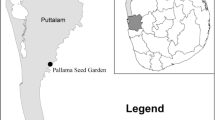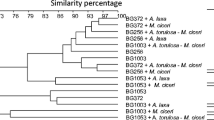Summary
Mixed cropping of cacao in coconut plantations improved the microbial activity in the rhizosphere of coconut which may be attributed to an increase in organic matter content of soil due to periodic shedding of cacao leaves. When compared to coconut cultivation without cacao, mixed cropping of coconut with cacao appeared to stimulate the population of bacteria and fungi in the rhizosphere of coconut, including the nitrogen fixing and phosphate solubilising bacteria. The occurrence of indole acetic acid producing Escherichia sp. on the root surface of coconut and the appearance of gibberellin(like-substance) producing Aspergillus flavus and A. fumigatus in the rhizosphere were other salient observations made in a pioneering study on the microbiology of the root region of plantation crops under mixed cropping. re]19750702
Similar content being viewed by others

References
Audus, L. J., Plant Growth Substances. Volume I. Chemistry and Physiology Leonard Hill Books, London (1972).
Becking, J. H., Nitrogen fixing bacteria of the genus Beijerinckia in South African soils. Plant and Soil 11, 193–206 (1959).
Bird, H. L. and Pugh, C. T., A paper chromatographic separation of giberellic acid and gibberellin A. Plant Physiol. 33, 45–57 (1958).
Chhonkar, P. K. and Subba Rao, N. S., Phosphate solubilisation by fungi associated with legume root nodules. Can. J. Microbiol. 13, 749–753 (1967).
Fred, E. B. and Waksman, S. A., Laboratory Manual of General Microbiology. McGraw Hill Book Company Inc. New York and London (1928).
Martin, J. P., Use of acid, rose bengal and streptomycin in the plate method for estimating soil fungi. Soil Sci. 69, 215–233 (1950).
Rao, W. V. B. S. and Sinha, M. K., Phosphate dissolving organisms in the soil and rhizosphere. Indian J. Agr. Sci. 33, 272–278 (1963).
Sarma, K. S. B., Studies on some physiological characteristics of Rhizobium in relation to symbiotic efficiency. Ph.D. thesis. Banaras Hindu University, Varanasi, India (1971).
Thornton, H. G., On the development of a standardized agar medium for counting soil bacteria with especial regard to the repression of spreading colonies. Ann. Applied Biol. 9, 241–274 (1922).
Walkley, A. and Black, I. A., An examination of the Degtjareff method for determining soil organic matter and proposed modification of the chromic acid titration method. Soil Sci. 37, 29–38 (1934).
Wareing, P. F. and Phillips, L. D. J., The Control of Growth and Differentiation in Plants. Pergamon Press, Oxford, New York, Toronto, Sydney and Braunschweig (1970).
Author information
Authors and Affiliations
Rights and permissions
About this article
Cite this article
Nair, S.K., Subba Rao, N.S. Microbiology of the root region of coconut and cacao under mixed cropping. Plant Soil 46, 511–519 (1977). https://doi.org/10.1007/BF00015910
Received:
Issue Date:
DOI: https://doi.org/10.1007/BF00015910



